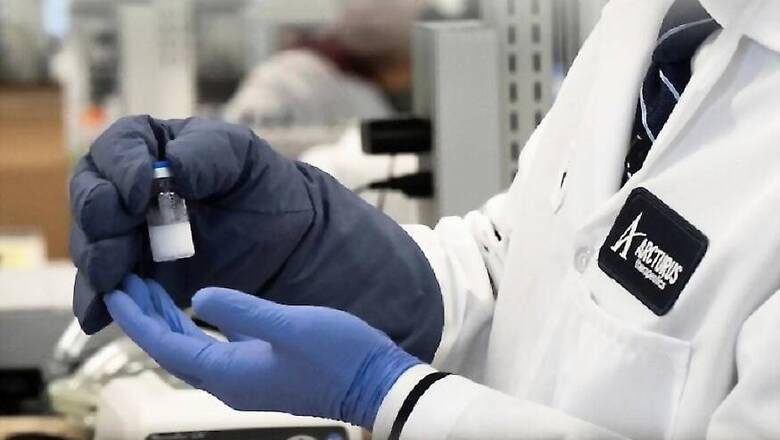
views
Washington: Hundreds of people are rolling up their sleeves in countries across the world to be injected with experimental vaccines that might stop Covid-19, spurring hope, maybe unrealistic that an end to the pandemic may arrive sooner than anticipated.
About 100 research groups are pursuing vaccines with nearly a dozen in early stages of human trials or poised to start. It's a crowded field, but researchers say that only increases the odds that a few might overcome the many obstacles that remain.
"We're not really in a competition against each other. We're in a race against a pandemic virus, and we really need as many players in that race as possible," Dr Andrew Pollard, who is leading the University of Oxford's vaccine study, told The Associated Press.
The hard truth: There's no way to predict which, if any, vaccine will work safely, or even to name a front-runner.
As Dr Anthony Fauci, the US government's top expert, put it: "You need more shots on goal for a chance at getting a safe and effective vaccine."
The first cautious tests of March, when small numbers of volunteers got injections to check for side effects, have turned into larger studies in China, the US and Europe to look for hints that different vaccine candidates really protect.
Next: Finding out for sure if any of the vaccines work in the real world by testing large groups of people in areas where the virus is circulating, a tricky prospect when study participants may be in places where the virus is fading or they are told to stay home, and finding a way to quickly distribute lots of doses of any successful candidates.
Policymakers are devising plans to try to overcome both obstacles in an attempt to compress the years it usually takes to develop a vaccine. Asked if a vaccine by January was possible, Dr Deborah Birx, the White House coronavirus task force coordinator, told Fox News Sunday "on paper, it's possible. It's whether we can execute."
Fauci has cautioned that even if everything goes perfectly, 12 to 18 months to develop a vaccine would set a speed record, and January will mark a year since the National Institutes of Health began creating its own Covid-19 vaccine, now in trials with Moderna Inc.
Depending how you count, there are between eight and 11 vaccine candidates in early stages of testing in China, the US, Britain and Germany, a collaboration between Pfizer Inc. and BioNTech last week began a study in Germany that's simultaneously testing four somewhat different shots. More study sites are about to open in still other countries and between May and July another handful of different vaccines is set to begin first-in-human testing.
There's no shortage of volunteers.
"This allows me to play a small role in fighting this thing," said Anthony Campisi, 33, of Philadelphia, who received his first test dose of Inovio Pharmaceuticals' DNA-based vaccine at the University of Pennsylvania last month.
"I can be a guinea pig."
The initial vaccine candidates work in a variety of ways. That's important because if one type fails, maybe another won't.
Different types of vaccines work better in some virus families than others. But for coronaviruses, there's no blueprint. Back in 2003 when scientists attempted vaccines against SARS, a cousin of the new virus, animal studies hinted at safety problems but then SARS disappeared and vaccine funding dried up. Vaccines against another COVID-19 cousin named MERS have only reached first-step safety testing.
"In 20/20 hindsight, we should have worked harder on coronavirus vaccines back then," said Dr Sten Vermund, dean of the Yale School of Public Health. Now, we're obligated to try a variety of strategies if we want fast results.
China's Sinovac and SinoPharm are testing "inactivated" vaccines, made by growing the new coronavirus and killing it. The companies have revealed little information about how the shots differ. But the technology is "tried-and-true polio shots and some types of flu vaccine are inactivated virus" although it's hard to scale up to rapidly produce millions of doses.
Most other vaccines in the pipeline aim to train the immune system to recognize a piece of the new coronavirus, mostly, the spiky protein that studs its outer surface.
One way: Use a harmless virus to carry the spike protein into the body. It's easier to produce but determining which virus is the best "carrier" is a key question.
China's CanSino Biologics brewed its vaccine using a common cold-causing adenovirus, engineered so it won't spread in the body. And in case people's immune systems fight off the cold virus before the vaccine can do its job, Pollard's Oxford team instead chose an adenovirus that normally infects chimpanzees.
Another way: Inject a piece of the coronavirus genetic code that instructs the body itself to produce spike protein that in turn primes the immune system to attack. It's a new and unproven technology but one that promises even faster production. Vaccines made by NIH and Moderna, Inovio Pharmaceuticals, and that Pfizer-BioNtech collaboration use genetic code approaches.
Still, more methods are next in line: Vaccine made of spike protein nanoparticles, and even a nasal spray alternative to shots.
Most vaccine studies so far are tracking safety and whether volunteers' blood shows any immune reactions. Some have jumped to larger numbers quickly, but there's still concern about being able to prove real-world protection


















Comments
0 comment